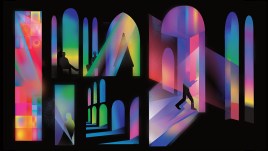Religious Landscape Study
The Religious Landscape Study (RLS) – conducted in 2007, 2014 and 2023-24 – surveys more than 35,000 Americans in all 50 states about their religious affiliations, beliefs and practices, along with their social and political views and demographic characteristics.
All Religious Landscape Study Publications

Religious Landscape Study: Database
Find survey data on religion and spirituality in 34 metro areas, all 50 states, major regions (like the South or the Midwest), or the whole United States. You can search for information on religious groups, demographic groups, or specific survey questions.

If the U.S. had 100 people: Charting Americans’ religious affiliations
If the U.S. had 100 people, 62 would be Christians, including 40 Protestants, 19 Catholics, two Latter-day Saints and two who identify with other Christian groups.

How religious is your state?
Explore our interactive database to find how religious adults are in your state based on service attendance, prayer, belief in God, and importance of religion.

How spiritual is your state?
Find out how adults in your state compare with other Americans on measures of spirituality, such as belief in souls, spiritual presences, an afterlife and more.

Muslim Americans share political attitudes with both the Democratic and Republican parties
Around half of Muslim adults (53%) identify with or lean toward the Democratic Party, while 42% identity with or lean toward the Republican Party.

Video: How do American men and women differ religiously?
The gender gap in American religion is shrinking. Historically, women have been more religious than men. But the gap is smaller than it once was.

Support for Christian prayer in U.S. public schools varies widely by state
Just over half of U.S. adults (52%) say they favor allowing public school teachers to lead their classes in prayers that refer to Jesus.

How U.S. Muslims compare with other Americans religiously and demographically
U.S. Muslims tend to be younger and more highly educated than other Americans. But they’re similar to Christians on many religiousness measures.

Video: How much ‘religious switching’ is there in the U.S.?
35% of U.S. adults no longer identify with the religion in which they were raised – that’s about 90 million people who have changed their religious identities.

Video: How religious are young Americans today?
Young adults today are less religious than older adults by traditional measures. But when it comes to spirituality, the differences are smaller.

Video: How common are spiritual beliefs in the U.S.?
In this video, we dive into the impact spirituality has on Americans and how it overlaps with and differs from religiousness.

Video: Religion and Spirituality in America
After years of decline, the U.S. Christian share has been relatively stable since 2019, while the rise in the share of religious “nones” has slowed – at least for now.

10 facts about U.S. Catholics
Catholics are one of the largest religious groups in the United States, outnumbering any single Protestant denomination.


